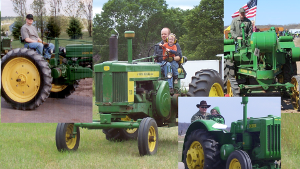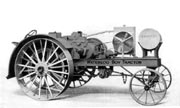Waterloo Boy R Engine
| Engine options | |
| Waterloo Gasoline Engine Company 5.4L 2-cyl kerosene | |
| Waterloo Gasoline Engine Company 6.5L 2-cyl kerosene | |
| Waterloo Gasoline Engine Company 7.6L 2-cyl kerosene |
| Engine Detail | |
| Waterloo Gasoline Engine Company | |
| kerosene | |
| 2-cylinder | |
| liquid-cooled | |
| Original engine, used until 1915, Waterloo Boy R serial number 1114 (RA to RD). This horizontal engine design was the basis for John Deere two-cylinder tractor engines used for the following forty-six years. | |
| Displacement | 330 ci 5.4 L |
| Bore/Stroke | 5.50x7.00 inches 140 x 178 mm |
| Compression | 3.91:1 |
| Rated RPM | 700 |
| Firing order | 1-2 |
| Starter type | hand-crank |
| Engine Detail | |
| Waterloo Gasoline Engine Company | |
| kerosene | |
| 2-cylinder | |
| liquid-cooled | |
| The six-inch bore engine was used on the Waterloo Boy R from 1915 until 1917 (RE to RK), serial number 6728. A detachable cylinder head was introduced at serial number 1610 (RH). | |
| Displacement | 396 ci 6.5 L |
| Bore/Stroke | 6.00x7.00 inches 152 x 178 mm |
| Compression | 3.91:1 |
| Rated RPM | 750 |
| Firing order | 1-2 |
| Starter type | hand-crank |
| Engine Detail | |
| Waterloo Gasoline Engine Company | |
| kerosene | |
| 2-cylinder | |
| liquid-cooled | |
| The final Waterloo Boy model R engine, used from 1917 to the end of production (RM). This engine size continued to be used in the Waterloo Boy model N and the early John Deere model D. | |
| Displacement | 465 ci 7.6 L |
| Bore/Stroke | 6.50x7.00 inches 165 x 178 mm |
| Compression | 3.91:1 |
| Rated RPM | 750 |
| Firing order | 1-2 |
| Starter type | hand-crank |
| Coolant capacity | 34 qts 32.2 L |
| Page information | |
 | |
| Copyright 2024 TractorData.com® | |
| TractorData is a family-owned small business located in Minnesota that has been providing reference information on tractors since 1999. | |
| Peter Easterlund - owner/author | |
| Email: Peter@TractorData.com | |
| Updated on April 5, 2022 |

